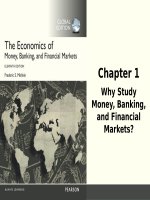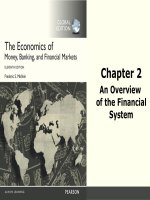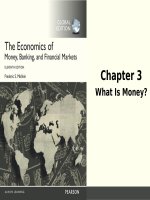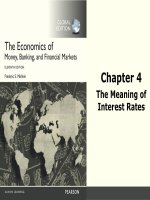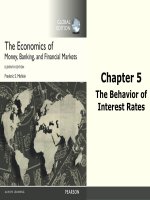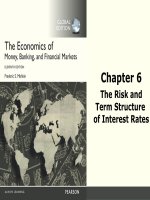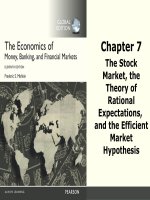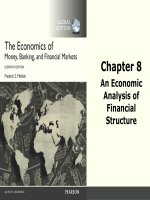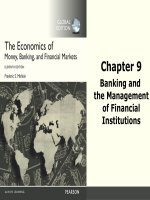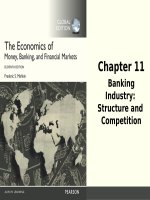The economics of money, banking, and financial institutions (11th edition) by f s mishkin ch18 the foreign exchange market
Bạn đang xem bản rút gọn của tài liệu. Xem và tải ngay bản đầy đủ của tài liệu tại đây (1.02 MB, 26 trang )
Chapter 18
The Foreign
Exchange Market
20-1
© 2016 Pearson Education Ltd. All rights reserved.
Preview
• This chapter outlines how the foreign
exchange market functions and how the
value of different currencies is determined.
20-2
18-2
© 2016 Pearson Education Ltd. All rights reserved.
Learning Objectives
• Explain how the foreign exchange market
works and why exchange rates are importance.
• Identify the main factors that affect exchange
rates in the long run.
• Draw the demand and supply curves for
foreign exchange market and interpret the
equilibrium in the market for foreign exchange.
• List and illustrate the factors that affect the
exchange rates in the short run.
20-3
18-3
© 2016 Pearson Education Ltd. All rights reserved.
Foreign Exchange Market
• Exchange rate: price of one currency in
terms of another
• Foreign exchange market: the financial
market where exchange rates are determined
• Spot transaction: immediate (two-day)
exchange of bank deposits
– Spot exchange rate
• Forward transaction: the exchange of bank
deposits at some specified future date
– Forward exchange rate
20-4
18-4
© 2016 Pearson Education Ltd. All rights reserved.
Foreign Exchange Market
• Appreciation: a currency rises in value
relative to another currency
• Depreciation: a currency falls in value
relative to another currency
• When a country’s currency appreciates, the
country’s goods become more expensive to
foreigners and foreign goods in that country
become less expensive to domestic economic
agents.
• Over-the-counter market mainly banks
20-5
18-5
© 2016 Pearson Education Ltd. All rights reserved.
Figure 1 Exchange Rates, 1990–
2014
Source: Federal Reserve Bank of St. Louis, FRED database: />20-6
18-6
© 2016 Pearson Education Ltd. All rights reserved.
Exchange Rates in the Long Run
• Law of one price
• Theory of Purchasing Power Parity
assumptions:
– All goods are identical in both countries
– Trade barriers and transportation costs are low
– Many goods and services are not traded across
borders
20-7
18-7
© 2016 Pearson Education Ltd. All rights reserved.
Figure 2 Purchasing Power Parity, United
States/United Kingdom, 1973–2014 (Index:
March 1973 = 100.)
Source: Federal Reserve Bank of St. Louis, FRED database: />20-8
18-8
© 2016 Pearson Education Ltd. All rights reserved.
Factors That Affect Exchange Rates
in the Long Run
• Relative price levels
• Trade barriers
• Preferences for domestic versus foreign
goods
• Productivity
20-9
18-9
© 2016 Pearson Education Ltd. All rights reserved.
Summary Table 1 Factors That Affect
Exchange Rates in the Long Run
20-10
18-10
© 2016 Pearson Education Ltd. All rights reserved.
Exchange Rates in the Short Run: A
Supply and Demand Analysis
• An exchange rate is the price of domestic
assets in terms of foreign assets
• Supply curve for domestic assets
– Assume amount of domestic assets is fixed
(supply curve is vertical)
• Demand curve for domestic assets
– Most important determinant is the relative
expected return of domestic assets
– At lower current values of the dollar (everything
else equal), the quantity demanded of dollar
assets is higher
20-11
18-11
© 2016 Pearson Education Ltd. All rights reserved.
Figure 3 Equilibrium in the Foreign
Exchange Market
20-12
18-12
© 2016 Pearson Education Ltd. All rights reserved.
Explaining Changes in Exchange
Rates
• Shifts in the demand for domestic assets
– Domestic interest rate
– Foreign interest rate
– Expected future exchange rate
20-13
18-13
© 2016 Pearson Education Ltd. All rights reserved.
Figure 4 Response to an Increase in
the Domestic Interest Rate, iD
20-14
18-14
© 2016 Pearson Education Ltd. All rights reserved.
Figure 5 Response to an Increase in
the Foreign Interest Rate, iF
20-15
18-15
© 2016 Pearson Education Ltd. All rights reserved.
Figure 6 Response to an Increase in the
Expected Future Exchange Rate, Eet+1
20-16
18-16
© 2016 Pearson Education Ltd. All rights reserved.
Summary Table 2
Factors That
Shift the
Demand Curve
for Domestic
Assets and Affect
the Exchange
Rate
20-17
18-17
© 2016 Pearson Education Ltd. All rights reserved.
Application: Effects of Changes in Interest
Rates on the Equilibrium Exchange Rate
• Changes in Interest Rates
– When domestic real interest rates raise, the
domestic currency appreciates.
– When domestic interest rates rise due to an
expected increase in inflation, the domestic
currency depreciates.
• Changes in the Money Supply
– A higher domestic money supply causes the
domestic currency to depreciate.
20-18
18-18
© 2016 Pearson Education Ltd. All rights reserved.
Figure 7 Effect of a Rise in the Domestic Interest
Rate as a Result of an Increase in Expected Inflation
Exchange Rate, Et
(euros/$)
S
Step 1. A rise in the domestic real interest as a
result of an increase in expected inflation shifts
the demand curve to the left . . .
Step 2. leading to a fall in the exchange rate.
E1
E2
1
2
D2
D1
Quantity of Dollar Assets
20-19
18-19
© 2016 Pearson Education Ltd. All rights reserved.
Application: Why are Exchange
Rates So Volatile?
• The volatility of exchange rates is due, in
part, to the fact that they are based on
unstable expectations regarding an
uncertain future.
20-20
18-20
© 2016 Pearson Education Ltd. All rights reserved.
Application: The Dollar and Interest
Rates
• The value of the dollar and the measure of real
interest rates tend to rise and fall together.
• Our model of exchange rate determination
helps explain the rise in the dollar in the early
1980s and fall thereafter.
– a rise in the U.S. real interest rate raises the relative
expected return on dollar assets, which leads to
purchases of dollar assets that raise the exchange
rate
20-21
18-21
© 2016 Pearson Education Ltd. All rights reserved.
Figure 8 Value of the Dollar and
Interest Rates, 1973–2014
Source: Federal Reserve Bank of St. Louis, FRED database: />20-22
18-22
© 2016 Pearson Education Ltd. All rights reserved.
Application: The Global Financial
Crisis and the Dollar
• During 2007 interest rates fell in the United
States and remained unchanged in Europe.
• The dollar depreciated
• Starting in the summer of 2008 interest
rates fell in Europe.
• Increased demand for U.S. Treasuries “flight
to quality”
• The dollar appreciated
20-23
18-23
© 2016 Pearson Education Ltd. All rights reserved.
Appendix: The Interest Parity
Condition
• Comparing Expected Returns on Domestic
and Foreign Assets
– Since the vast majority of real world transactions
in currency markets involve economic agents
buying and selling currencies based on their
value as assets, one must develop an
understanding of how these assets are valued.
20-24
18-24
© 2016 Pearson Education Ltd. All rights reserved.
Appendix: The Interest Parity
Condition
• From the perspective of an American
economic agent, the expected return on
dollar-denominated assets is equal to the
domestic rate of interest.
• For a foreign economic agent, Francois the
Foreigner, the expected return on dollardenominated assets is equal to the rate of
interest associated with those same assets,
adjusted for an expected appreciation or
depreciation in the value of the U.S. dollar
relative to the Euro.
20-25
18-25
© 2016 Pearson Education Ltd. All rights reserved.
